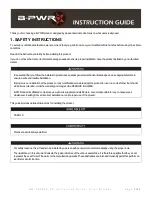
WELDKAR WELDING HELMET
AIRFORCE 980-S TH3PSL
20
1. SAFETY PRECAUTIONS-READ
BEFORE USE
1.1 SYMBOL USE
DANGER! - indicates a hazardous situation which, if
not avoided, will result in death or serious injury. The
possible hazards are represented by the following
symbols or explained in the text.
Note - indicates statements not related to personal
injury.
1.2 ARC WELDING HAZARDS
WARNING
ELECTRIC SHOCK
may be fatal
Touching live electrical parts can cause fatal shocks or
severe burns. The electrode and electrical circuitry are
always live when the power is on. The power supply
circuit and the machine’s internal circuits are also live
when the power is on. In semi-automatic or automatic
welding with welding wire, the wire, spool, drive roller
housing and all metal parts touching the welding wire
are live.
1. Do not touch any live components.
2. Wear dry, insulating gloves without holes and a body
protector.
3. Insulate yourself from the workpiece and the ground
with dry, insulating mats or covers.
4. Disconnect power source or stop engine before
installing or servicing this equipment. Lock the main
power switch in the open position or remove the
main fuses to prevent accidental power-up.
5. Install and ground this equipment in accordance with
the Owner’s Manual and national and local codes.
6. Turn all equipment OFF when not in use. Turn off the
power to the equipment when it is left unattended or
when it is taken out of service.
7. Use fully insulated electrode bases. Never put the
holder in water to cool it or place it on the floor
or work surface. Never touch electrode holders
connected to two welding machines at the same
time and do not touch other people with the holder
or the electrode.
8. Do not use worn, damaged, undersized, or poorly
connected cables.
9. Do not wrap the cables around the body.
10. Ground the workpiece for proper electrical
grounding.
11. Do not touch the electrode while it is in contact with
the working circuit (grounding chain).
12. Use only properly maintained equipment. Repair or
replace damaged parts immediately.
13. In closed or humid rooms, do not use a welding
machine with an AC outlet unless it is equipped with
a voltage reduction device Use equipment with a
DC output.
14. Wear a safety harness to prevent falling when
working above floor level.
15. Keep all panels and covers securely in place.
WARNING
BOOSTARES can burn the eyes and
skin;
Arc rays from the welding process produce intense heat
and powerful ultraviolet rays that can burn the eyes and
skin. Noise from some processes can damage hearing.
1. Wear a welding helmet with the correct shade to
protect
protect your face and eyes during welding or viewing.
eyes during welding or viewing.
2. Wear approved safety goggles. Safety glasses
are recommended.
3. Use protective shields or barriers
to protect others from flashing and glare; warn others
not to
glare; warn others not to look into the arc.
arc.
4. Wear protective clothing made of durable
Hardly flammable material (wool and leather) and
foot protection.
5. Use approved earplugs or ear defenders when the
noise level is high.
when the noise level is high.
6. Never wear contact lenses during welding.
WARNING
FUMES AND GASES
can damage your health.
Fumes and gases are released during welding. Inhaling
these fumes and gases can damage your health.
1. Keep your head out of the fumes. Do not inhale the
fumes.
2. If you are working inside, ventilate the room well
and/or use an extraction fan at the arc to remove
the welding fumes and gases.
3. In case of poor ventilation, use an approved
respirator with air supply.
4. Read the safety data sheets and the manufacturer’s
instructions for metals, consumables, coatings and
cleaning products.
5. Only work in an enclosed area if it is well ventilated
or when using a respirator with air supply. The
shielding gases used in welding can displace the air
and cause injury or death. Make sure the air is safe
to breathe.
6. Do not weld in areas where degreasing, cleaning
or spraying operations are taking place. The heat
and jets from the arc may react with fumes to form
highly toxic and irritating gases.
7. Do not weld on coated metals such as galvanised
steel or steel coated with lead or cadmium unless
the coating has been removed from the welding
area, the area is well ventilated and, if necessary,
you are wearing a respirator with air supply. The
coatings and all metals containing these elements
may emit toxic fumes during welding.
!
!
!
















































